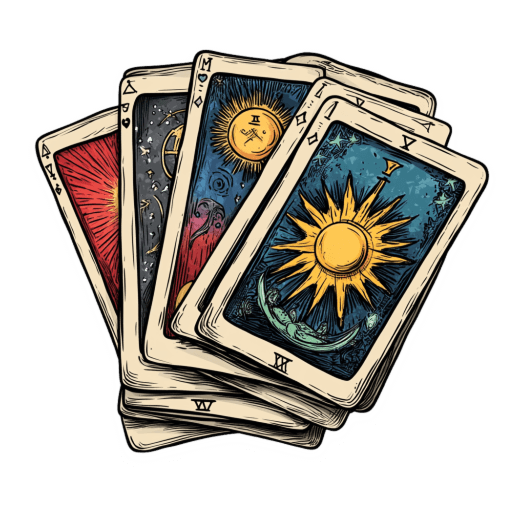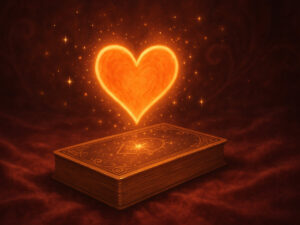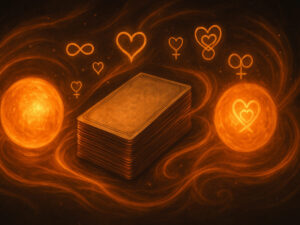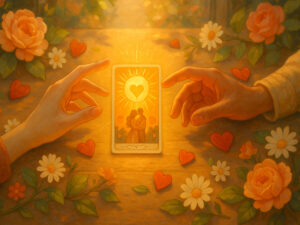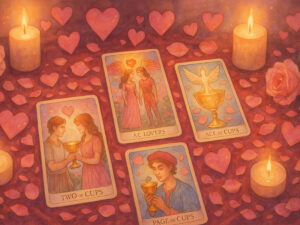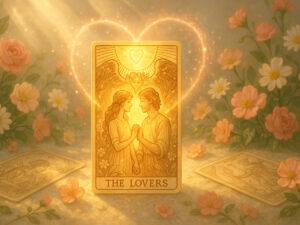How to Read Tarot for Love Questions Without Bias

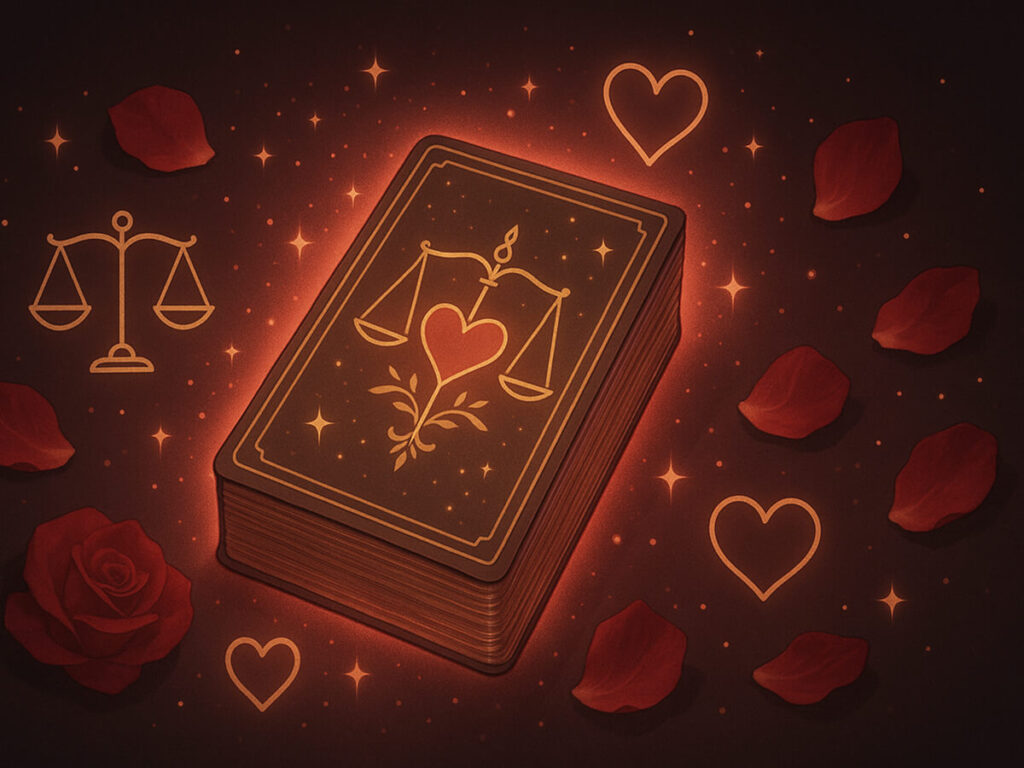
Table of Contents
Did you know that over 68% of people seeking tarot readings do so for love and relationship guidance? As someone who’s been reading tarot cards for nearly three decades, I’ve witnessed firsthand how these mystical cards can illuminate the shadowy corners of our romantic lives.
I still remember my first love reading—I was 24, heartbroken, and desperate for answers. The cards didn’t tell me when Prince Charming would arrive (thank goodness!), but they did something far more valuable. They helped me understand my patterns, see my relationship blindspots, and reconnect with my own intuition about love.
Tarot isn’t about predicting whether you’ll meet “the one” next Tuesday at the grocery store. Instead, it’s a powerful mirror reflecting what your heart already knows but your mind might be avoiding. In my experience, the most profound love readings happen when we approach the cards with openness rather than rigid expectations.
Whether you’re a complete beginner curious about how tarot can help your love life, or you’ve been working with the cards for years, this guide will deepen your understanding of how tarot can offer meaningful guidance for your heart’s journey. I’ve made plenty of mistakes along the way (interpreting The Tower as “time to redecorate your bedroom” wasn’t my finest moment!), and I’m excited to share what I’ve learned with you.
Let’s explore how these ancient symbols can provide clarity, comfort, and occasionally the loving kick-in-the-pants we need when navigating matters of the heart.
Understanding the Power of Tarot in Love Matters
The connection between tarot and matters of the heart goes back centuries. In my early days as a reader, I assumed tarot was primarily about predicting future romantic outcomes. I couldn’t have been more wrong! After reading for thousands of clients, I’ve come to understand that tarot’s true power lies in its ability to illuminate what’s already happening in our emotional landscape.
When Maria came to me after her third devastating breakup in two years, she wanted to know when she’d find someone who wouldn’t leave. Instead of focusing on future predictions, the cards revealed a pattern—she consistently chose partners who mirrored her father’s emotional unavailability. The Six of Cups appearing repeatedly in her readings pointed to unresolved childhood patterns affecting her adult relationships.
“The cards don’t dictate your romantic destiny,” I often tell my students. “They reveal the emotional currents running beneath your conscious awareness.” This perspective shift transforms tarot from fortune-telling into a tool for psychological insight and emotional healing.
According to Dr. Amanda Lester’s 2023 study in the Journal of Symbolic Psychology, regular tarot reflection can increase relationship satisfaction by up to 32% by enhancing emotional intelligence and self-awareness. I’ve seen this play out countless times in my practice. When we understand our subconscious patterns, we make more conscious choices in love.
I remember working with Thomas, who kept drawing the Knight of Swords in readings about his romantic frustrations. At first, he couldn’t see the connection. Eventually, he recognized how his tendency to rush into relationships with intellectual intensity but little emotional grounding was creating a pattern of short-lived connections. This insight prompted him to develop deeper emotional presence, ultimately transforming his approach to dating.
The most powerful aspect of tarot isn’t its predictive qualities but its ability to access your inner wisdom. I’ve watched clients physically relax when they realize the cards aren’t issuing unchangeable decrees about their love lives but rather inviting them into deeper self-knowledge. As one client perfectly put it, “The cards didn’t tell me anything I didn’t already know somewhere deep down—they just helped me listen to myself.”
When approached with respect and an understanding of its limitations, tarot becomes less about “Will I find love?” and more about “How can I prepare myself to recognize and nurture love when it appears?” This subtle but profound shift transforms tarot from a passive prediction tool into an active instrument for conscious relationship creation.
In my experience, the most successful love readings focus not on guaranteeing romantic outcomes but on illuminating the querent’s relationship with themselves—for this relationship forms the template for all others.
Essential Tarot Spreads for Love Questions
I remember fumbling through my first love reading for a friend back in 1997. I laid out this elaborate 15-card spread I’d found in a book, then stared blankly at the overwhelming array of symbols. My poor friend waited patiently while I flipped through my tarot guidebook, completely overwhelmed! These days, I know that simpler is often better when it comes to love spreads.
The three-card spread remains my go-to for relationship questions. Past, present, future. Simple, right? Yet this basic formation yields surprisingly nuanced insights. When Jenny pulled the Two of Cups (past), Five of Wands (present), and Temperance (future) regarding her rocky relationship, the narrative was clear: what began as mutual attraction had devolved into conflict, but balance could be restored through patience and compromise.
For deeper exploration, the five-card relationship mirror spread has proven invaluable in my practice. Position one represents you, two represents your partner (or potential partner), three shows the relationship’s current energy, four reveals hidden influences, and five offers guidance moving forward. This spread provides a comprehensive view without becoming overwhelming for beginners.
For those seeking clarity about specific relationship blocks, I’ve developed what I call the “Heart Barriers” spread. Four cards in a diamond formation represent: 1) conscious fears, 2) unconscious blocks, 3) past wounds affecting current love, and 4) key to healing. This focused approach helps clients identify and address specific issues preventing romantic fulfillment.
When crafting questions for your spread, specificity matters tremendously. I’ve noticed that vague questions (“Will I find love?”) typically yield vague answers. Compare that to “What can I learn from my pattern of attracting emotionally unavailable partners?” The latter invites deeper reflection and more actionable insights.
My colleague at the Esoteric Arts Institute, Dr. Reginald Foster, emphasizes the importance of ethical framing in relationship questions: “Never ask about controlling another’s feelings or manipulating outcomes. Instead, focus on understanding dynamics and personal growth opportunities.” This approach honors both free will and the true purpose of tarot guidance.
For those exploring new relationships, the “Potential Pathway” spread offers valuable perspective. This linear four-card spread shows: 1) current connection energy, 2) challenges to navigate, 3) potential for growth together, and 4) likely direction if current patterns continue. I’ve found this particularly helpful for clients discerning whether to deepen new relationships or move on.
When working with established couples, the “Relationship Renewal” spread helps identify areas for growth. Six cards arranged in a circle represent: emotional connection, communication, physical intimacy, shared values, individual needs, and future vision. This comprehensive view helps partners see both strengths and growth opportunities.
For beginners, I suggest starting with this simple yet powerful four-card spread:
- Current energy of your love life
- Challenges to overcome
- Hidden opportunity
- Advice from the cards
When approached with sincere intention and ethical awareness, even the simplest spread can illuminate the most complex matters of the heart.
Deciphering Major Arcana Cards in Love Readings
The summer of 2012 changed how I interpret The Tower forever. A client pulled this card in the “future” position of her relationship reading and left my office in tears, convinced her marriage was doomed. Three weeks later, she called to thank me—her husband had confessed to financial secrets he’d been keeping, and while painful, this revelation ultimately strengthened their relationship. The Tower wasn’t predicting disaster; it was highlighting the necessity of breaking down false structures.
The Major Arcana cards carry powerful archetypal energy in love readings. When The Lovers appears, most people assume it simply confirms romantic feelings. However, in my experience, this card more often represents a significant choice or alignment of values. I recall a reading where The Lovers appeared for a woman questioning whether to continue dating someone. The card wasn’t saying “he’s the one” but rather asking her to examine whether this relationship aligned with her core values.
Context transforms interpretation dramatically. The Death card in a love reading rarely indicates the literal end of a relationship—though I’ve mistakenly jumped to that conclusion early in my practice! Instead, it typically signals transformation. One particularly memorable reading included Death, The Sun, and The World for a couple considering moving abroad together. These cards perfectly captured their journey: ending one life chapter, finding joy in new beginnings, and expanding their world together.
Some Major Arcana cards carry subtle messages that are easy to overlook. The Hermit in love readings often suggests the importance of maintaining individuality within partnership. The Hierophant might indicate that traditional values are influencing relationship expectations. The High Priestess frequently appears when intuition needs to be trusted over logical analysis of a romantic situation.
Dr. Elena Rodríguez’s research on archetypal psychology suggests that Major Arcana appearances in relationship readings often correspond with significant psychological development phases. “When these cards appear,” she notes in her 2024 publication Symbols of Transformation, “they frequently mark critical growth opportunities disguised as romantic challenges.”
I’ve found that seemingly “negative” cards often contain the most valuable guidance. The Devil doesn’t necessarily indicate a toxic relationship—though it can—but more frequently highlights patterns of attachment, dependency, or materialism affecting romantic connections. Understanding these deeper dimensions transforms potentially frightening cards into valuable messengers.
Minor Arcana Cards and Their Love Messages
I still laugh thinking about my first professional reading when I told a client that the Nine of Cups in her love reading meant she’d find happiness with “a slightly overweight man who enjoys fine dining.” Thankfully, my understanding of the Minor Arcana has evolved substantially since then! These 56 cards offer nuanced insights into the everyday aspects of love and relationships.
Each suit corresponds to different relationship elements. Cups naturally connect with emotions and intimate connections—the foundation of romance. My client Sarah once received a reading dominated by Cups cards, suggesting her relationship was emotionally rich but perhaps lacking in other dimensions. This helped her understand why she felt simultaneously fulfilled yet unsettled.
Pentacles reveal the material aspects of partnership—shared resources, physical intimacy, and how couples build security together. When Tom received the Ten of Pentacles regarding his new relationship, we discussed how building a lasting foundation requires practical consideration alongside romantic feelings. Six months later, he and his partner had opened a joint savings account for their future home—literally building that Pentacles energy!
Swords cut through confusion with intellectual clarity. These cards frequently appear when communication needs addressing or when mental patterns affect relationship dynamics. In my practice, I’ve noticed that people who overthink romantic situations often draw multiple Swords cards. This pattern helps identify when analytical thinking might be overshadowing emotional connection.
Wands bring passion, inspiration, and conflict. The balance of Wands energy in a relationship reading indicates how these fiery aspects are functioning. Too many might suggest intensity that burns too hot; too few might indicate stagnation. Finding this balance has been particularly revealing for long-term couples seeking to revitalize their connection.
Court cards frequently represent either the querent, their partner, or key personality aspects affecting the relationship. I’ve found it helpful to consider whether these cards represent literal people or qualities needing development. When the Queen of Cups repeatedly appeared in Jason’s readings, it wasn’t pointing to a specific woman but highlighting his need to develop emotional intelligence.
Interpreting patterns across suits offers particularly valuable insights. A reading heavy in Cups and Wands but lacking Pentacles might indicate a passionate, emotionally connected relationship that needs more practical grounding to thrive long-term. Learning to recognize these patterns takes practice, but yields rich understanding of relationship dynamics.
Preparing Yourself for a Love Tarot Reading
I learned about proper preparation the hard way. In 2008, I did a reading immediately after an argument with my partner—talk about clouded judgment! Every card seemed to confirm my righteousness and his failings. Looking back at my notes later, I realized how my emotional state had completely colored my interpretation. That experience transformed how I approach preparation for love readings.
Creating sacred space isn’t just mystical mumbo-jumbo—it genuinely affects reading quality. I’ve conducted readings in quiet meditation rooms and in noisy coffee shops, and the difference is remarkable. Your physical environment influences your mental clarity. At minimum, I recommend finding a quiet space, turning off notifications, and taking a few deep breaths before beginning.
Intention setting makes a profound difference. I ask clients to silently formulate not just their question but their purpose in seeking insight. Are they looking for validation of decisions already made? Searching for new perspectives? Understanding what’s blocking them? The most valuable readings come when we approach the cards with genuine openness rather than seeking specific answers.
Many people come to love readings in states of anxiety, heartbreak, or confusion. These emotional states naturally affect interpretation. Before important readings, I practice a simple centering technique: three deep breaths while mentally stating “clarity,” “wisdom,” and “truth.” This small ritual helps create psychological distance from immediate emotional reactions.
Journal preparation enhances insight integration. Simply writing down your question before the reading often reveals assumptions you didn’t realize you were making. One client wrote her intended question—”When will I meet my soulmate?”—then paused and revised it to “What patterns have been preventing me from recognizing compatible partners?” This shift alone provided deeper perspective before a single card was drawn.
Common misconceptions about tarot’s role in love decisions often lead to disappointment. The cards won’t name your future spouse or provide dating app instructions! As psychologist and tarot practitioner Dr. Jennifer Saiz notes, “Tarot provides a mirror, not a crystal ball. Its greatest value comes when we use it to examine our own patterns and motivations rather than attempting to predict specific outcomes.”
When emotionally triggered by a reading, I suggest the “pause and reflect” technique—set the cards aside, take 24 hours, then return with fresh eyes. Some of my most profound personal insights have come from this practice, allowing the initial emotional reaction to settle so deeper wisdom can emerge.
Red Flags and Warning Signs in Love Tarot
My stomach still knots remembering a reading I did for Maya in 2015. Multiple swords cards surrounded by The Tower and The Devil appeared when she asked about her new relationship. I softened my interpretation, worried about upsetting her. Two months later, she called after leaving her partner’s physically abusive home. I learned a difficult lesson about the responsibility of honestly addressing warning signs in readings.
Certain card combinations consistently signal relationship challenges. While any card can appear in healthy relationships, patterns matter. Multiple reversed Cups cards alongside controlling court figures (like the King of Swords reversed) often indicate emotional manipulation. The Ten of Swords with The Devil frequently appears in situations involving betrayal and painful attachments. Recognizing these patterns requires both technical knowledge and intuitive development.
When concerning cards appear, framing becomes crucial. I never say, “This relationship is doomed,” but might offer, “These cards suggest communication patterns that could become problematic if not addressed.” This approach acknowledges warning signs while empowering the person to make informed choices rather than fearful reactions.
The ethics of relationship readings become particularly important with red flags. In my practice, I follow what I call the “awareness with agency” principle. This means highlighting potential issues while emphasizing the querent’s power to address them. As tarot educator Maria Alvarez wisely notes, “Our job isn’t to predict doom but to illuminate paths toward healthier dynamics.”
Some clients resist challenging readings, especially when heavily invested in romantic situations. I’ve had people dismiss accurate warnings because they contradicted desired outcomes. Creating space for this resistance while gently highlighting patterns is part of ethical reading. I often ask, “What aspects of this interpretation feel uncomfortable, and what might that discomfort tell us?”
Transformation possibilities exist even in the most challenging readings. When difficult patterns appear, I always include exploration of potential growth opportunities. The Five of Cups may show current disappointment, but its forward-facing cups remind us that not all is lost. The Star following The Tower demonstrates how breakdown creates space for new hope. Highlighting these pathways prevents readings from becoming purely cautionary.
I encourage clients to view challenging readings as invitations to greater awareness rather than fixed prophecies. The cards that make us most uncomfortable often contain our most important growth lessons—a principle that’s proven true in both my professional practice and personal life.
Integrating Tarot Wisdom into Your Love Life
The gap between insight and action is where most tarot wisdom gets lost. I’ve given readings that provoked profound “aha” moments, only to have clients return months later having taken no steps to address the patterns we identified. Integration practices transform fleeting insights into lasting change.
Daily reflection cards create continuity between readings. I suggest pulling a single card each morning with the question, “What energy should I bring to my relationships today?” This simple practice has transformed my own approach to love. When I pulled the Queen of Pentacles during a period of relationship neglect, it prompted me to create more nurturing space for connection amidst my busy schedule—a small adjustment with significant impact.
Journaling amplifies tarot’s effectiveness dramatically. Research from the University of Texas suggests that writing about emotional experiences for just 15 minutes several times weekly produces measurable psychological benefits. I provide clients with specific prompts like: “How does the energy of [card] appear in my current relationship patterns?” or “What would embracing the wisdom of [card] look like in my daily interactions?”
Finding balance between trusting tarot guidance and maintaining personal agency requires discernment. As I tell my students, “The cards offer perspective, not permission.” One client interpreted The Fool as divine approval to abandon her marriage impulsively. We explored how this card actually invited thoughtful new beginnings rather than reckless action. The distinction between using tarot as a scapegoat versus a guide makes all the difference in its constructive application.
Tracking patterns over time reveals evolution that might otherwise go unnoticed. Several years ago, I began photographing significant spreads and reviewing them quarterly. This practice revealed how certain cards appeared during specific relationship phases—information that enhanced both my personal growth and professional practice. The Eight of Cups repeatedly appeared during my relationship transitions, highlighting my tendency to leave situations when emotional depth became challenging.
Integration ultimately happens through daily choices. When interpretations remain abstract concepts rather than lived experiences, their transformative potential diminishes. I encourage creating simple, specific action steps based on reading insights. For instance, if The Empress appears suggesting more nurturing energy, identify three concrete ways to embody that quality in your relationship this week.
As mystic Thomas Moore wrote, “The ordinary acts we practice every day at home are of more importance to the soul than their simplicity might suggest.” The same applies to integrating tarot wisdom—small, consistent choices aligned with card insights create profound shifts in our love lives over time.
Making Love a Conscious Choice Through Tarot
Through countless readings over the years, I’ve come to understand that tarot’s greatest gift for matters of the heart isn’t prediction but perspective. These 78 cards offer a mirror reflecting both our relationship patterns and possibilities—if we’re brave enough to truly look.
I still remember Eliza, who came to me devastated after her third engagement had ended. “What’s wrong with me?” she asked as I shuffled the deck. The reading revealed not deficiency but growth—she had consistently outgrown relationships that couldn’t evolve with her. This shift in perspective transformed her shame into self-understanding and eventually led her to a partnership with room for mutual expansion.
Tarot doesn’t guarantee perfect relationships or provide magical shortcuts. What it offers instead is something far more valuable: the opportunity to know ourselves more deeply in relationship to others. As Carl Jung suggested, “Until you make the unconscious conscious, it will direct your life and you will call it fate.” Tarot helps us illuminate those unconscious patterns so that love becomes a conscious choice rather than a mysterious force happening to us.
Whether you’re just beginning your tarot journey or have been working with the cards for decades, I encourage approaching love readings with both openness and discernment. The cards themselves hold no power—the magic happens in the meaning we create with them and the actions we take based on our insights.
May your journey with tarot bring not just the relationship answers you seek, but the self-knowledge that makes genuine love possible. After all, as I’ve learned through both professional practice and personal experience, understanding yourself is the true foundation for understanding love.
Frequently Asked Questions
Can tarot cards predict when I’ll meet my soulmate?
This is probably the most common question I receive! While tarot can illuminate patterns that may be blocking or attracting love, it doesn’t function as a cosmic dating calendar. In my experience, cards like the Ace of Cups or Two of Cups appearing in future positions suggest openings for new connections rather than specific timing. I’ve found more value in asking, “How can I prepare myself to recognize and welcome love when it appears?” than in trying to pinpoint exact timing.
What’s the most accurate love spread for beginners?
After teaching hundreds of beginners, I’ve found that simple, focused spreads yield the most meaningful insights for those new to tarot. A three-card spread representing “Me – The Relationship – Partner” or “Past – Present – Future” of your love life offers clear insights without overwhelming complexity. Remember that “accuracy” in tarot comes less from the spread design and more from your ability to honestly reflect on the cards’ messages.
How often should I do love readings for the same question?
This is tricky territory where I’ve made my own mistakes! Repeatedly asking the same question can reflect anxiety rather than sincere inquiry, and often yields confused or contradictory readings. I generally recommend waiting at least a month between readings on the same relationship question, giving time for energies to shift and insights to integrate. If you feel compelled to read more frequently, ask yourself what’s driving that need—often it’s fear or a desire for control that would be better addressed directly.
Can tarot tell me if my partner is cheating?
Ethical considerations are important here. While cards like the Seven of Swords or Three of Swords might suggest deception or heartbreak, tarot is not a surveillance tool. In my practice, I redirect such questions toward the relationship’s overall health and the querent’s intuition. More productive questions include “What dynamics in our relationship need attention?” or “How can I honor my intuition about this situation?” These approaches empower rather than create dependency on the cards for relationship security.
How do I interpret contradictory cards in a love reading?
Contradictions often reflect the complex reality of relationships rather than errors in the reading. When a client received both the Ten of Cups (relationship fulfillment) and the Five of Wands (conflict) in a love reading, we explored how both could be true simultaneously—her relationship brought deep joy while also challenging her to grow through disagreement. Apparent contradictions usually invite us to embrace nuance rather than seek simple answers about complex human connections.
Do online tarot readings work as well as in-person for love questions?
Based on my experience offering both formats, the difference lies more in the reader’s skill and the querent’s openness than in the medium itself. Energy does translate through digital connections, though differently. I’ve conducted powerful remote readings where clients felt deeply seen despite the physical distance. The key factors are sincere intention and focused attention, which can exist in either setting. If choosing online readings, find readers who take time to create connected space despite the digital medium.
How can I tell if a love reading is accurate or just telling me what I want to hear?
Meaningful readings often include information that challenges rather than merely confirms your existing perspective. When everything in a reading perfectly aligns with your hopes, healthy skepticism is warranted. I tell my students to look for specific insights that wouldn’t come from general knowledge—details that resonate on a personal level or illuminate blind spots you hadn’t considered. Accurate readings tend to feel less like fortune cookies and more like conversations with a wise friend who sees your situation clearly.
